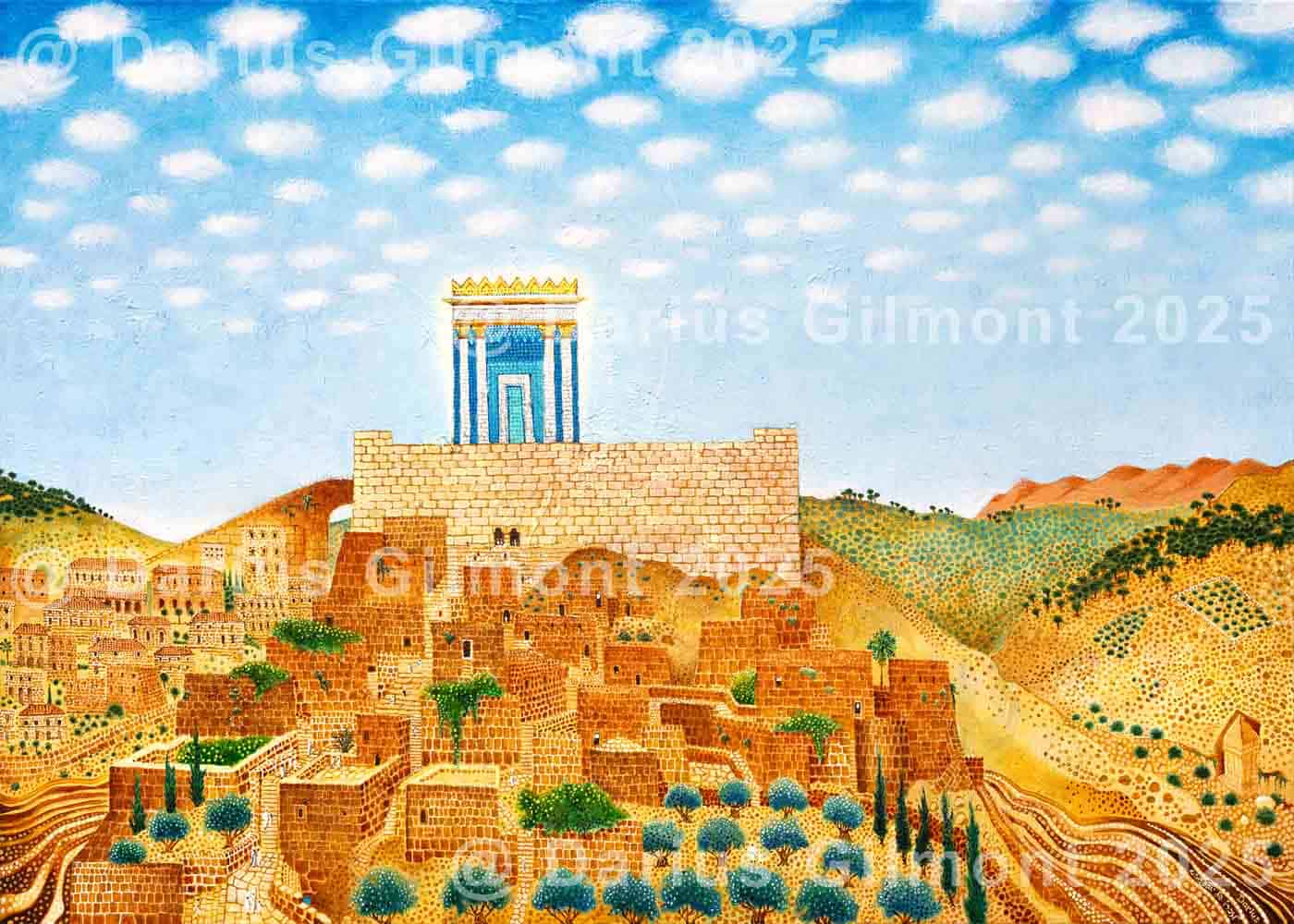
The Temple, the Jaguar & the Kung Fu Lesson
This is a post about three paintings: A view of the Second Temple in Jerusalem, a Jaguar E-type sports car,
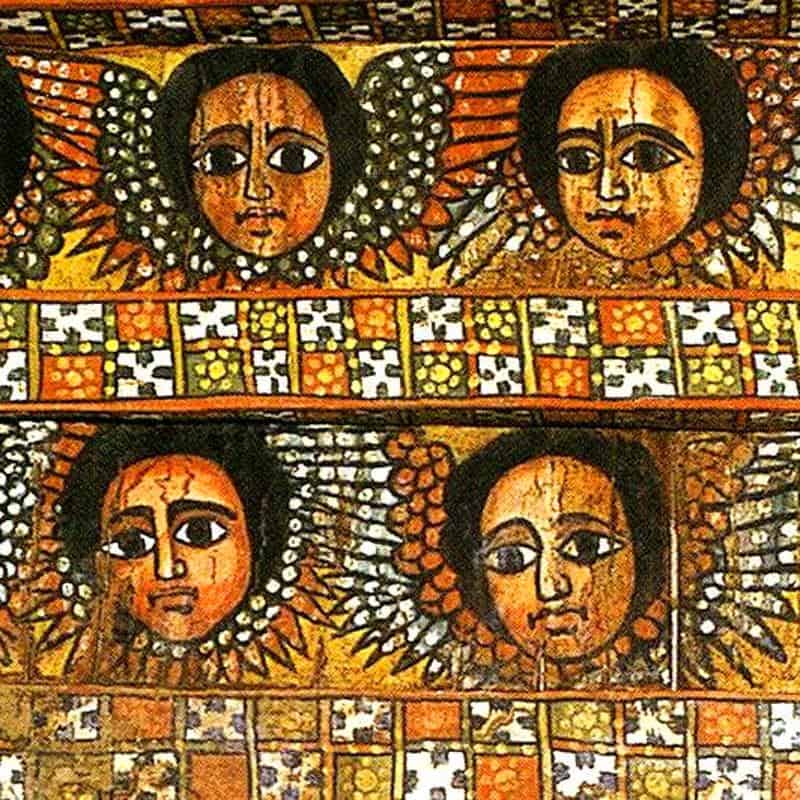
Artists have for centuries painted their visions of the Bible. Adorning churches and manuscripts across the world, Biblical artists have created powerful visual embodiments of the Scriptures, and in so doing have represented the collective consciousness of mankind. Biblical art has mostly been the preserve of Christendom, while Jewish lore forbade figurative art. Judaic religious authority feared the viewer may invest these images with magical powers, tantamount to idol worship. So Jewish artists limited themselves to decorating religious artifacts. Some figurative art did appear in Pessach Haggadot, and sometimes as Biblical illustration in synagogue decoration (see example below). Recently the Jewish world has shown a greater acceptance of figurative art, while retaining a certain sensitivity to the portrayal of the human figure, and especially figures from the Bible.
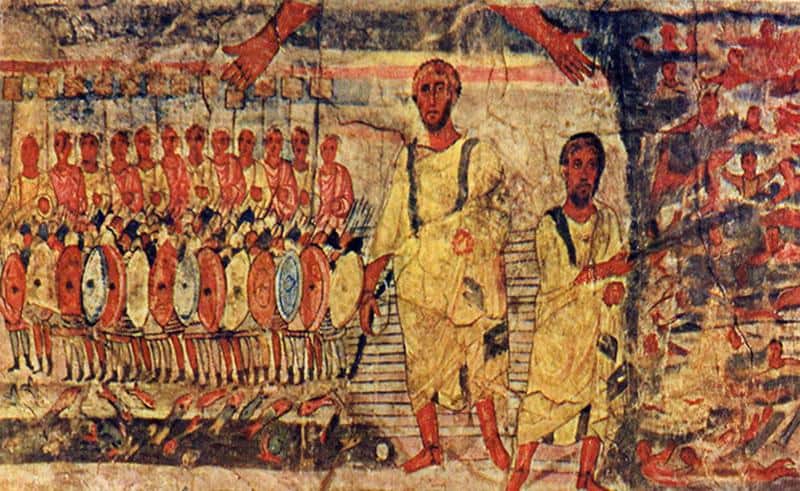
Is there a distinct lineage running through the history of art that you might call Jewish Art? Christendom through the ages invested vast resources in building cathedrals. Islam developed a highly refined aesthetic encompassing everything from sacred geometry to miniature paintings illuminating Persian manuscripts. But Judaism was always concerned with the Temple within and reached the heights of intellectual and spiritual dialectic in the Talmud.
David Gelernter, artist and Yale computer scientist, produces paintings based around words in Hebrew. He says, in relation to the idea of Jewish art and specifically to his work:
“I’ve been trying for many years……..to figure out what Jewish art is, if there is such a thing. It’s come to seem to me that Jewish art is paintings of words. Not just paintings in which words appear, or words on a wall, but paintings in which the words themselves have meaning and decorative significance and conceptual weight.”
(Source: David Gelernter, video interview, 23 April 2010 , 01:47)
I would define Jewish art as art which focuses specifically on Jewish subject matter, as opposed to art by artists who happen to be Jewish.
In Jewish tradition, the Torah (Hebrew Bible or Old Testament) is the direct and most pure word of G-d. But secular Western thinkers consider the Bible an agglomeration of ancient texts attributed to several different and mysterious authors.
Jordan Peterson has given a powerful series of lectures about the psychological meaning of the Bible as “the foundational document of Western culture.” Describing the Biblical account of creation, he says that G-d “(speaks) habitable order into being.” This refers to the primacy of the word in the Bible. In Jewish tradition, word is central to G-d’s original and ever-unfolding creation of the world. Meanwhile, in the term habitable being, Peterson puts man at the centre of creation. In Jewish tradition, man is held as the very reason that G-d created the world.
In general, Peterson says the Bible is made up of “dreamlike ideas that …….constitute the ground from which our more articulated and explicit ideas have emerged.” He describes how deeply embedded the Biblical stories are in the psyche of Western culture. From a Jewish point of view the Bible is the original document defining the meaning of life. And for an artist, it is one of the richest and most meaningful sources of imagery.
One of the influences on my approach to Biblical illustration is the naive religious art of Ethiopia. What captivates me is the simple power of the childlike figures with their big, all-knowing eyes. This feature of Coptic art has been termed the “reversal gaze.” A really striking example of this is the painted ceiling at the Debre Berhan Selassie monastery in Gondar. Part of this extensive and repetitive work is shown at the top of this page.
More recently, and in Israel, artists who have used what I would call this “knowing-eye” mannerism are Yosl Bergner and, to an extent, the lesser known painter Michael Falk. I’ve found both these artists inspiring for their direct, naive approach. The simplicity of their work is beguiling. It creates a sense of wonder and mystery that is lacking in more studied, academic art. It does, however, lack the power which you feel in the robust and tough graphic work of Ben Shahn. I was introduced to Ben Shahn when I was about 13, and the clearly drawn figures, combined with the most beautiful lettering and texts, made a deep impression. Until now, these have been the main influences on my Bible artwork.
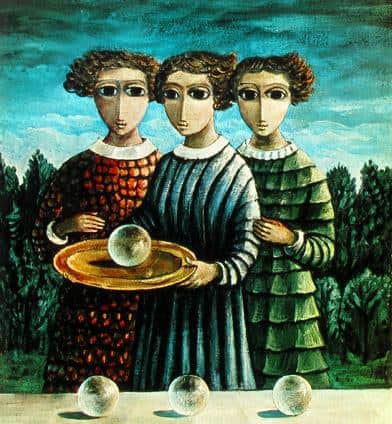
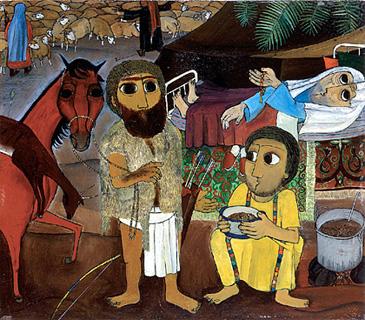
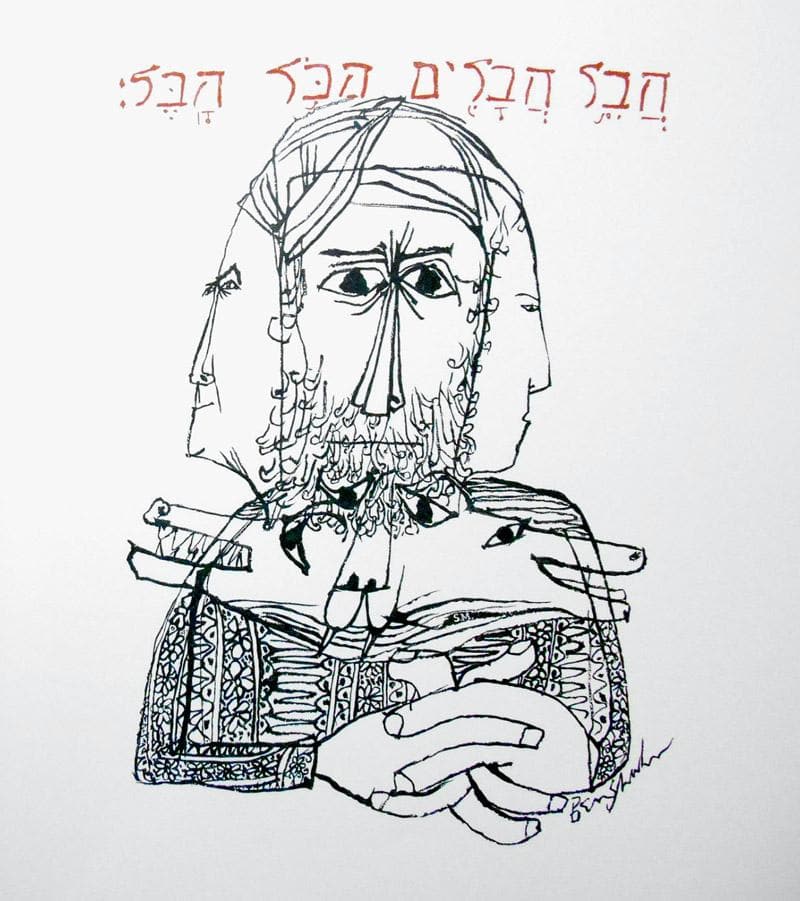
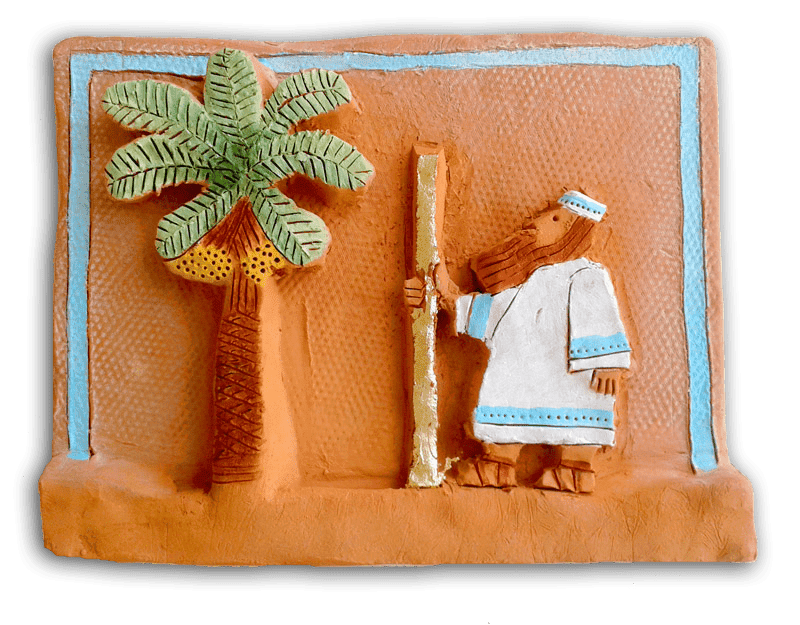

This is a post about three paintings: A view of the Second Temple in Jerusalem, a Jaguar E-type sports car,
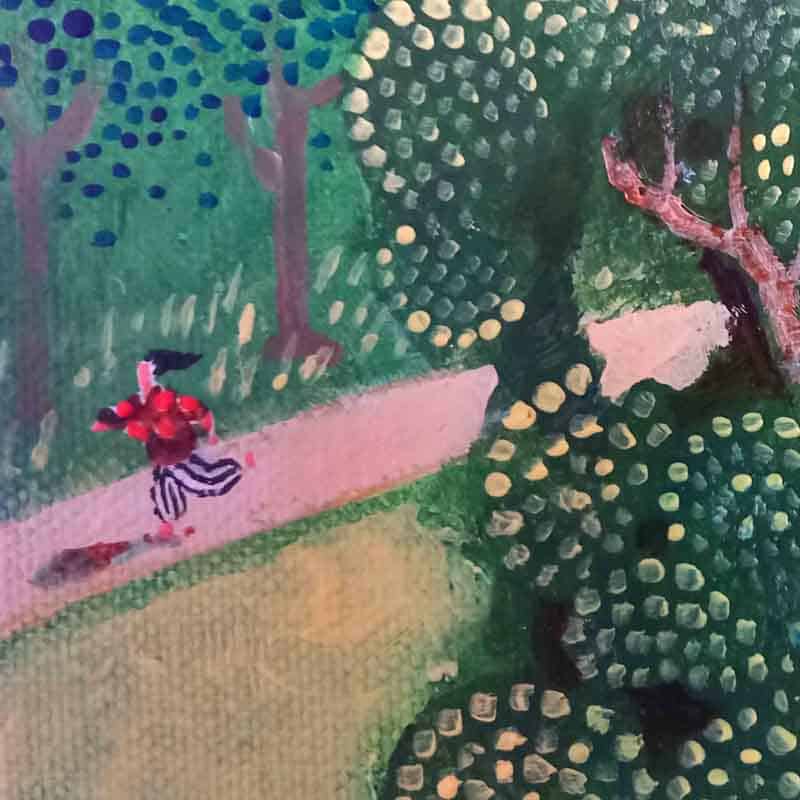
I want to try to explain, from my point of view, what it feels like to be living here in Israel in these critical and dangerous times. One of the friends I’ve made through my art, who lives in Oregon, wrote me this: “………How are you in Israel REALLY doing?”
Artists have for centuries painted their visions of the Bible. Adorning churches and manuscripts across the world, Biblical artists have created powerful visual embodiments of the Scriptures, and in so doing have represented the collective consciousness of mankind. Biblical art has mostly been the preserve of Christendom, while Jewish lore forbade figurative art. Judaic religious authority feared the viewer may invest these images with magical powers, tantamount to idol worship. So Jewish artists limited themselves to decorating religious artifacts. Some figurative art did appear in Pessach Haggadot, and sometimes as Biblical illustration in synagogue decoration (see example below). Recently the Jewish world has shown a greater acceptance of figurative art, while retaining a certain sensitivity to the portrayal of the human figure, and especially figures from the Bible.

Is there a distinct lineage running through the history of art that you might call Jewish Art? Christendom through the ages invested vast resources in building cathedrals. Islam developed a highly refined aesthetic encompassing everything from sacred geometry to miniature paintings illuminating Persian manuscripts. But Judaism was always concerned with the Temple within and reached the heights of intellectual and spiritual dialectic in the Talmud.
David Gelernter, artist and Yale computer scientist, produces paintings based around words in Hebrew. He says, in relation to the idea of Jewish art and specifically to his work:
“I’ve been trying for many years……..to figure out what Jewish art is, if there is such a thing. It’s come to seem to me that Jewish art is paintings of words. Not just paintings in which words appear, or words on a wall, but paintings in which the words themselves have meaning and decorative significance and conceptual weight.”
(Source: David Gelernter, video interview, 23 April 2010 , 01:47)
I would define Jewish art as art which focuses specifically on Jewish subject matter, as opposed to art by artists who happen to be Jewish.
In Jewish tradition, the Torah (Hebrew Bible or Old Testament) is the direct and most pure word of G-d. But secular Western thinkers consider the Bible an agglomeration of ancient texts attributed to several different and mysterious authors.
Jordan Peterson has given a powerful series of lectures about the psychological meaning of the Bible as “the foundational document of Western culture.” Describing the Biblical account of creation, he says that G-d “(speaks) habitable order into being.” This refers to the primacy of the word in the Bible. In Jewish tradition, word is central to G-d’s original and ever-unfolding creation of the world. Meanwhile, in the term habitable being, Peterson puts man at the centre of creation. In Jewish tradition, man is held as the very reason that G-d created the world.
In general, Peterson says the Bible is made up of “dreamlike ideas that …….constitute the ground from which our more articulated and explicit ideas have emerged.” He describes how deeply embedded the Biblical stories are in the psyche of Western culture. From a Jewish point of view the Bible is the original document defining the meaning of life. And for an artist, it is one of the richest and most meaningful sources of imagery.
One of the influences on my approach to Biblical illustration is the naive religious art of Ethiopia. What captivates me is the simple power of the childlike figures with their big, all-knowing eyes. This feature of Coptic art has been termed the “reversal gaze.” A really striking example of this is the painted ceiling at the Debre Berhan Selassie monastery in Gondar. Part of this extensive and repetitive work is shown at the top of this page.
More recently, and in Israel, artists who have used what I would call this “knowing-eye” mannerism are Yosl Bergner and, to an extent, the lesser known painter Michael Falk. I’ve found both these artists inspiring for their direct, naive approach. The simplicity of their work is beguiling. It creates a sense of wonder and mystery that is lacking in more studied, academic art. It does, however, lack the power which you feel in the robust and tough graphic work of Ben Shahn. I was introduced to Ben Shahn when I was about 13, and the clearly drawn figures, combined with the most beautiful lettering and texts, made a deep impression. Until now, these have been the main influences on my Bible artwork.



